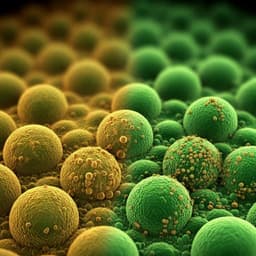
Physics
Storage of photonic time-bin qubits for up to 20 ms in a rare-earth doped crystal
A. Ortu, A. Holzäpfel, et al.
Innovative research by Antonio Ortu, Adrian Holzäpfel, Jean Etesse, and Mikael Afzelius reveals the remarkable storage of photonic time-bin qubits for an impressive 20 milliseconds in a specialized crystal. This achievement significantly enhances qubit storage times, marking a breakthrough in solid-state quantum memory technologies.
~3 min • Beginner • English
Introduction
The study addresses the challenge of realizing long-duration, on-demand quantum memories needed for quantum repeaters and networked quantum communication. Ensemble-based repeaters, originating from the DLCZ proposal, benefit from multiplexing to increase entanglement distribution rates. Rare-earth-ion doped crystals are promising due to long optical and spin coherence times and inherent multimode capacity. Prior demonstrations of spin-wave storage of weak optical states in Eu3+:Y2SiO5 were limited to ~1 ms, insufficient for near-term repeaters that require at least ~10 ms to hundreds of ms. Long-duration storage is hampered by noise generated during dynamical decoupling (DD) required to combat spin inhomogeneous dephasing and spectral diffusion. The paper investigates whether combining modest magnetic fields to extend spin coherence with error-compensating DD sequences can enable low-noise, long-duration storage at the single-photon level, and whether quantum coherence can be verified by storing time-bin qubits with high fidelity.
Literature Review
The work builds on ensemble-based quantum memories and repeaters using multiplexing (time and spectral) and AFC spin-wave protocols. Rare-earth crystals have demonstrated long optical coherence (e.g., Pr3+, Eu3+) and exceptionally long hyperfine coherence under suitable conditions (up to hours in certain systems). Previous spin-wave storage of single-photon-level states in Eu3+:Y2SiO5 reported durations ~1 ms. Techniques to extend spin coherence include applying weak magnetic fields to reduce spectral diffusion and dynamical decoupling with error-compensating sequences (e.g., XY-type sequences). However, DD introduces read-out noise through pulse imperfections. The study situates itself at the intersection of these advances, testing whether a small static magnetic field combined with optimized DD can push storage beyond 10 ms while maintaining quantum-level performance, and introduces a composite adiabatic pulse approach for time-bin qubit analysis to avoid efficiency penalties of partial readouts with short pulses.
Methodology
Platform: A 151Eu3+:Y2SiO5 crystal operated at ~4 K in a closed-cycle cryostat. The Eu3+ nuclear spin (I = 5/2) yields three hyperfine doublets in ground and excited states, enabling a Λ-system with |g⟩, |e⟩, and |s⟩ levels for AFC spin-wave storage. A small static magnetic field (~1.35 mT along crystal D1) enhances spin coherence and produces Zeeman splittings.
AFC spin-wave protocol: The memory is prepared with an atomic frequency comb on |g⟩→|e⟩ with periodicity Δ (AFC delay 1/Δ), and |s⟩ emptied by optical pumping. Input photons are absorbed and rephase after 1/Δ unless a strong optical transfer pulse moves excitation to |s⟩. Storage in |s⟩ is protected by an RF DD sequence on |g⟩↔|s⟩ (46.18 MHz). A second optical transfer returns the excitation to |e⟩, followed by AFC-driven emission on |e⟩→|g⟩.
Laser/optics: 580 nm light generated by frequency-doubling a 1160 nm laser locked to a high-finesse cavity, delivering ~1.8 W. Multiple AOM channels control optical transfer, memory preparation, filter preparation, and input beams. The input beam passes twice through the memory crystal (waist ~50 μm); preparation and transfer beams are overlapped with larger waists (~700 μm and 250 μm, respectively). After the cryostat, detection uses a linear photodiode (bright pulses) or a Si SPAD (single-photon level). A filtering stage with two Eu:Y2SiO5 crystals (optically pumped to create spectral transmission windows around input frequency and absorption at transfer frequency) and a temporal AOM gate suppresses scattered/read-out noise; overall filter absorption window optical depth ~7.4, giving extinction ≈ e^{7.4}:1 (~1636:1). Effective memory spectral width is limited by the transfer pulse bandwidth (~1.5 MHz) even though the AFC is prepared over ~3 MHz.
AFC characterization and parameters: With 1.35 mT || D1, measured AFC exponential decay with effective AFC coherence time TAFC = 240 ± 30 μs and extrapolated zero-time AFC efficiency η0 = (36 ± 3)%. A modulation period of ~25 μs in the AFC efficiency versus 1/Δ corresponds to the excited-state Zeeman splitting 41.4 kHz; choosing 1/Δ as a multiple of this avoids comb degradation.
Transfer pulses: Adiabatic, chirped HSH pulses (per Tian et al.) are used for uniform inversion over bandwidth constraints. Given 1/Δ = 25 μs, HSH pulse duration is 15 μs (bandwidth ~1.5 MHz). The remaining 10 μs accommodates six temporal modes with mode spacing Tm = 1.65 μs; each mode contains a Gaussian pulse (FWHM ~700 ns).
Dynamical decoupling: RF DD sequences (XX, XY-4, XY-8, XY-16) at 46.18 MHz protect against inhomogeneous spin dephasing and spectral diffusion. Trade-offs include required pulse number/separation versus noise and crystal heating. Pulse errors contribute to read-out noise; error-compensating sequences mitigate area errors but heating and other imperfections may dominate.
Measurement procedures: Bright-pulse characterization uses a photodiode to extract storage efficiency versus spin storage time Ts (time between the two optical transfer pulses). Data are fit to a Mims spectral diffusion model ηs(Ts) = ηs(0) exp[−2 (Ts/Tspin)^m], extracting effective spin coherence time Tspin and Mims factor m. Single-photon-level characterization employs SPAD detection; input and retrieved signals and noise are histogrammed (200 ns bins). The noise probability PN is measured by running the full sequence without input in the relevant temporal windows; for 50 and 100 ms storage, PN is estimated from a ~225 μs window after read-out exploiting the 1.9 ms radiative lifetime of spontaneous emission noise. Quantities μin (mean input photons per mode at memory), PN, efficiency η (internal, excluding output path losses), SNR, and μ1 = PN/η are computed by summing counts over Tm, normalizing by repetitions, and correcting for detector efficiency (η0 = 57%) and path transmission (17–20%).
Time-bin qubit storage and analysis: Two time-bin qubits, each ideally |ψin⟩ = (|E⟩ + |L⟩)/√2, are encoded into modes (2,3) and (5,6) among six total modes. For full state tomography, σz is measured from mode-resolved histograms; σx and σy require partial read-outs separated by Tm. Instead of two short control pulses, the authors introduce a composite adiabatic cHSH pulse formed by the linear sum of two identical HSH pulses separated by Tm. This produces an effective 50% partial transfer independent of pulse duration and Tm, enabling projections onto superposition bases with phase θ between the two components setting the measurement basis (θ = 0, π for σx; θ = π/2, 3π/2 for σy). cHSH provides better SNR after filtering compared to using the filtering crystals as AFC-based analyzers.
Key Findings
- Long-duration multimode storage: Demonstrated storage of six temporal modes at the single-photon level for Ts = 20, 50, and 100 ms in 151Eu3+:Y2SiO5 with DD and a 1.35 mT magnetic field.
- Single-photon-level metrics (averaged over six modes):
• 20 ms (XY-4): μin = 0.711 ± 0.006; PN = (7.3 ± 1.2)×10−3; η = 7.39 ± 0.04%; SNR = 7.4 ± 0.5; μ1 = 0.098 ± 0.002.
• 50 ms (XY-8): μin = 1.21 ± 0.01; PN = (9 ± 2)×10−3; η = 4.37 ± 0.04%; SNR = 5.6 ± 0.7; μ1 = 0.218 ± 0.008.
• 100 ms (XY-16): μin = 1.062 ± 0.007; PN = (11.0 ± 1.5)×10−3; η = 2.60 ± 0.02%; SNR = 2.5 ± 0.2; μ1 = 0.445 ± 0.008.
- Internal storage efficiency reference: For 20 ms, an internal storage efficiency ηs ≈ 7% with SNR 7.4 ± 0.5 at μ̄in ≈ 0.711 photon/mode. At 100 ms, ηs = (2.60 ± 0.02)% with SNR 2.5 ± 0.2 at μ̄in ≈ 1.06.
- AFC characteristics with B = 1.35 mT || D1: TAFC = (240 ± 30) μs; extrapolated η0 = (36 ± 3)%; first maximum at 1/Δ = 25 μs used (AFC echo efficiency ~28%).
- Spin coherence extension via DD: Effective Tspin from bright-pulse decays: XX: 70 ± 2 ms; XY-4: 106 ± 9 ms; XY-8: 154 ± 11 ms; XY-16: 230 ± 30 ms. Scaling Tspin(np) ∝ Tspin(1) np^γ with γ = 0.57 ± 0.03 and T2(1) = (47 ± 2) ms, consistent with Ornstein–Uhlenbeck spectral diffusion.
- Qubit storage and fidelity: Stored two time-bin qubits for 20 ms and performed full tomography using cHSH analyzer; obtained average output fidelity F = (85 ± 2)% at average photons per qubit n̄in = 0.92 ± 0.04.
- Noise behavior: PN ~ (7–11)×10−3 across 20–100 ms; at 20 ms, XX, XY-4, XY-8 yielded similar PN ≈ (7.4, 8.1, 8.6)×10−3, indicating higher-order DD suppresses pulse area errors; residual read-out noise likely due to other mechanisms (e.g., RF-induced population transfer followed by spontaneous emission).
Discussion
The results demonstrate that a modest static magnetic field combined with appropriate DD sequences enables coherent spin-wave storage of single-photon-level temporal modes well beyond 10 ms, reaching 100 ms while maintaining SNR > 1 and internal efficiencies of a few percent. The experimentally observed increase in effective spin coherence time with the number of DD pulses aligns with Ornstein–Uhlenbeck spectral diffusion, suggesting that further increases in storage time are feasible by increasing pulse numbers, provided technical constraints (notably heating) are mitigated. The AFC performance at 1.35 mT preserves comb quality and supports efficient operation when 1/Δ is matched to the excited-state splitting. The trade-off between multimode capacity and efficiency is managed by choosing 1/Δ = 25 μs and HSH pulse parameters that allow six modes with sufficient bandwidth. At the quantum level, storing time-bin qubits for 20 ms with F ≈ 85% confirms that coherence is preserved through spin-wave storage, DD protection, and read-out. The newly introduced cHSH analyzer enables efficient and flexible projection measurements in superposition bases without sacrificing adiabatic pulse advantages, improving SNR relative to AFC-based analyzers in the filtering crystals. Remaining performance limitations at longer storage times include reduced single-photon-level efficiency compared to bright-pulse estimates, likely due to long-term alignment and coupling drifts, and read-out noise driven primarily by RF-induced processes rather than simple pulse area errors. Overall, the work significantly extends solid-state time-bin qubit storage durations and provides a scalable analysis technique, supporting the viability of rare-earth-doped crystals for time-multiplexed quantum repeater architectures.
Conclusion
The study reports spin-wave AFC storage of six single-photon-level temporal modes in 151Eu3+:Y2SiO5 for up to 100 ms, and coherent storage of time-bin qubits for 20 ms with high fidelity (85 ± 2%). A small magnetic field and carefully chosen DD sequences extend spin coherence, with Tspin scaling as expected for a Markovian (Ornstein–Uhlenbeck) spectral diffusion regime. The composite adiabatic cHSH pulse enables efficient time-bin qubit analysis without compromising transfer efficiency, improving SNR over alternative analyzers. These advances represent a roughly 40-fold increase in qubit storage time in a solid-state device compared to previous results and indicate the feasibility of long-duration, multimode quantum memories for repeater applications.
Future directions include engineering improvements to mitigate RF-induced heating and associated optical frequency drifts, further optimization of DD sequences and RF pulse shaping to reduce read-out noise, stabilization of optical alignment to maintain efficiency during long acquisitions, exploring higher optical depths and cavity enhancement for increased efficiency, and scaling to larger numbers of temporal and spectral modes while preserving fidelity over even longer storage times.
Limitations
- Technical heating from intense, frequent RF DD pulses causes temperature-dependent optical frequency shifts, limiting the number of pulses and hence storage duration.
- Read-out noise arises primarily from RF-induced population transfer and subsequent spontaneous emission; its detailed mechanisms remain not fully understood.
- Single-photon-level storage efficiencies at 50 ms and 100 ms are lower than bright-pulse characterizations, likely due to long-term alignment and fiber coupling drifts during lengthy acquisitions.
- Potential beating effects and scattered data at longer DD sequences may result from multiple phase pathways and small ground-state Zeeman splittings relative to RF pulse chirps.
- Analyzer trade-offs: Using filtering crystals as AFC analyzers degraded SNR; while cHSH improved SNR, it projects onto a single eigenstate per measurement, requiring multiple settings for full tomography.
- Effective memory bandwidth limited by transfer pulse bandwidth (~1.5 MHz), not the full prepared AFC bandwidth (~3 MHz), constraining shortest storable pulses and total multimode capacity.
Related Publications
Explore these studies to deepen your understanding of the subject.







